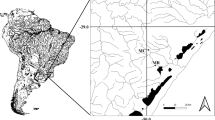Abstract
Fecundity of four species of catfishes, namely, Mystus seenghala (Sykes), Mystus cavasius (Ham), Wallagonia attu (Bloch) and Heteropneustes fossilis (Bloch), was studied. The fecundity of Mystus seenghala and Mystus cavasius varied between 20064 to 46443 and 3314 to 63135 respectively. In Wallagonia attu and Heteropneustes fossilis it varied between 66070 to 453148 and 1375 to 46737 respectively. In all the four species fecundity has a linear relationship with body weight and gonad weight, and a parabolic relationship with length in all the fishes excepting Mystus seenghala, where it is linear. By subjecting the data to multiple regression analysis, it is observed that the fecundity of each species can be most accurately determined by taking two variables together. In all the fishes studied the relative fecundity (Egg/body wt.) does not change significantly either with length or body weight.
Similar content being viewed by others
References
Bagenal, T. B. 1957. The breeding and fecundity of the long rough dab. Hippoglossoides platessoides (Fabr) and the associated cycle in condition. J. Mar. biol. Ass. U.K., 36: 339–373.
Bhargava, R. M. S. 1971. The fecundity of Heteropneustes fossilis (Bloch). J. Bombay. nat. Hist. Soc. 67 (3): 583–588.
Bhatt, V. S. 1968. Studies on the biology of some freshwater fishes. Part VII Heteropneustes fossilis (Bloch). Indian J. Fish. 15: 99–115.
Bhatt, V. S. 1970. Studies on the biology of some freshwater fishes. Part IV. Mystus seenghala (Sykes). J. Bombay nat. Hist. Soc., 67 (2): 194–211.
Bhatnagar, G. K. 1964. Observation on the spawning frequency and fecundity of Bhakra Reservoir fishes. Indian J. Fish., 11(1): 485–502.
Clark, F. N. 1934. Maturity of the California sardine (Sardina caerulea) determined by the ova diameter measurements. Fish. Bull. Sacramento. 42: 1–49.
Corbin, P. G. 1948. On the seasonal abundance of young fish. IX. The year 1947. J. mar. biol. Ass. U.K., 27: 718.
Corbin, P. G. 1952. The seasonal abundance of young fish IX. The year 1949. J. Mar. Biol. U.K., 30: 271.
Das, B. K. 1927. The bionomics of certain air-breathing fishes of India, together with an account of the development of their air-breathing organs. Phil. Trans., 216: 183–219.
David, A. 1963. Sexual Dimorphism, Fecundity and Food of the Estuarine Bagrid, Mystus gulio (Ham) Proc. Natn. Acad. Sci. India Allahabad. 33 (3): 385–410.
Farran, G. P. 1938. On the size and number of the ova of Irish herring. J. Cons. int. Explor. Mar., 13: 91–100.
Franz, V. 1910. Die Eiproduktion der Scholle (Pleuronectes platessa L.) Wiss. Meeresuntersuch, 9: 59–141.
Kisseilvitch, K. A. 1923. Materials on the biology of Caspian herrings—The fertility of the Volga-Caspian herrings. Astrachan. Ichthy. Lab. Rept., 5: 15–55.
Lehman, B. A. 1953. Fecundity of Hudson River Shad. Res. Rep. U.S. Fish and Wildlife Services, 23: 1–8.
Mathur, P. K. 1964. Maturity and fecundity of Hilsa ilisha (Hamilton) in the Upper Stretches of the Ganga. Indian J. Fish., 11 (1): 423–448.
Pantulu, V. R. 1963. Studies on the Age and growth, Fecundity and spawning of Osteogeneiosus militaris (Linn). J. Cons. int. Explor. Mar., 28: 295–315.
Qasim, S. Z. & Qayyum, A. 1963. Fecundities of some freshwater fishes. Proc. nat. Inst. Sci., 29: 373–382.
Saha, K. C. & Guha, B. C. 1939. Nutritional investigation on Bengal fish. Indian J. med. Res., 26: 921–927.
Saigal, B. N. & Motwani, M. P. 1963. Studies on the fishery and biology of commercial Catfishes of the Ganga River System, I. Early life History, bionomics and breeding of Mystus (Osteobagrus) seenghala (Sykes). Ind. J. Fish., 8 (1): 60–75.
Samachar, 1976. Catfish in your Court Yard. The Navhind Times, Tuesday, July 27, Page 2.
Simpson, A. C. 1951. The fecundity of the plaice. Fish. Invest. Lond., 17: 1–29.
Author information
Authors and Affiliations
Rights and permissions
About this article
Cite this article
Bhatt, V.S., Dalal, S.G. & Abidi, S.A.H. Fecundity of the freshwater catfishes mystus seenghala (sykes), mystus cavasius (ham), wallagonia attu (bloch) and heteropneustes fossilis (bloch) from the plains of Northern India. Hydrobiologia 54, 219–224 (1977). https://doi.org/10.1007/BF00014288
Received:
Published:
Issue Date:
DOI: https://doi.org/10.1007/BF00014288




